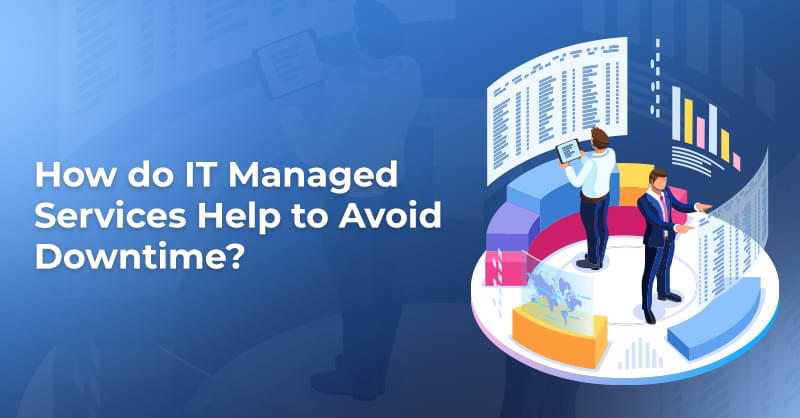How do IT Managed Services help to Avoid Downtime?

Written by Manpreet Kaur
Content Writer
September 27, 2022
Modern-day businesses must be accessible 24×7 round the clock and without a pause. The expanding count of mobile users, IoT, and the potential to engross users always need continuous and consistent uptime. Downtime during peak hours adversely affects businesses, compromising productivity, efficiency, and customer relationship management. Since all businesses depend heavily on technology, downtimes can prove disastrous. Read this blog to discover how IT Managed Services can help prevent costly downtimes.
What is Downtime, and how much does it cost?
Downtime refers to the period when a specific IT system is not available and operational. It brings about big financial risks and losses impacting customer loyalty and trust. Some leading causes of downtime include hardware failure, human errors, maintenance shutdowns, and environmental disasters. To calculate your company’s downtime costs, use the formula below, depending on your business size and number of minutes downtime continues.
Downtime Cost = Minutes of Downtime x Cost-per-minute
A Gartner study states that the average cost of downtime is $5,600 per minute. Another report from the Ponemon Institute reveals the average downtime cost is approximately twice, i.e., $9,000 per minute. For small and mid-size businesses, the predicted downtime cost lies between
$137 and $427 per minute.
What is the best way to avoid Downtimes?
Using IT Managed Services is the best model that helps business organizations prevent and cope with negative impacts of downtime ensuring that the business is always-on. It monitors the workings of the tools and technologies during mission-critical tasks, enabling high uptime and minimal service interruptions.
Remote Monitoring: Remote monitoring refers to the standard specification that allows monitoring of network operational activities and business processes with the help of remote devices. Regular remote machine monitoring enables the workforce to monitor the equipment uninterruptedly after its installation. In addition, the surveillance machines allow quick diagnostics, automatic recalibrations, and rapid maintenance, thereby impeding downtimes.
Risk Assessment: Regular risk assessment identifies and suggests remedies for all vulnerabilities that threaten critical assets, procedures, protocols, and policies of a business. It helps assess and mitigate risks during information transfer and detect threats so that business owners can look for solutions to address them.
Vulnerability Testing: Vulnerability testing refers to detecting IT systems’ security risks to lessen possibility of data breaches. It scans the operating systems, networks, system and application software to detect susceptibilities such as poor design and invalid authentication.
Vulnerability assessment prevents unauthorized access to software and hardware, ensuring high security. It includes a five-step process – Setup, Test Execution, Vulnerability Analysis, Reporting, and Remediation.
Penetration Testing: Penetration testing is a fabricated cyber-attack against the IT system to identify exploitable loopholes. It makes attempts to break into frontend/backend servers and APIs. The outcomes of this test are used to amplify the Web Application Firewall (WAF) and repair issues. It has five testing stages: Planning and Reconnaissance, Scanning, Obtaining Access, Maintaining Access, and Analysis and WAF configuration.
Endpoint Protection: The endpoint protection ensures high-grade security for all network access points of a business. For example, the BYOD (Bring Your Own Device) policy allows employees to bring their devices – mobiles, laptops, and tablets to workstations. This results in sufficient scope for vulnerabilities and security lapses.
Components of Endpoint Protection Software
- Antimalware and antivirus protection
- Web security
- Data classification and data loss prevention
- Integrated firewall
- Email gateway
- Threat forensics
- Endpoint management platform
- Endpoint, email, and disk encryption
A trustworthy Managed Service Provider makes your business resilient to downtimes by incorporating the right tools and techniques. At Royal Cyber, we offer top-notch IT Managed Services to ensure 24×7 business continuity. Our global presence & certified IT managed services team is always willing to take on new challenges and anticipate the needs of your business. Reach out to us to know how we can help you ensure high performance with 100% uptime.
Recent Blogs
- An Insight into ServiceNow Hardware Asset Management (HAM) Ramya Priya Balasubramanian Practice Head ServiceNow Gain …Read More »
- Learn to write effective test cases. Master best practices, templates, and tips to enhance software …Read More »
- In today’s fast-paced digital landscape, seamless data integration is crucial for businessRead More »



